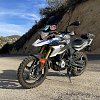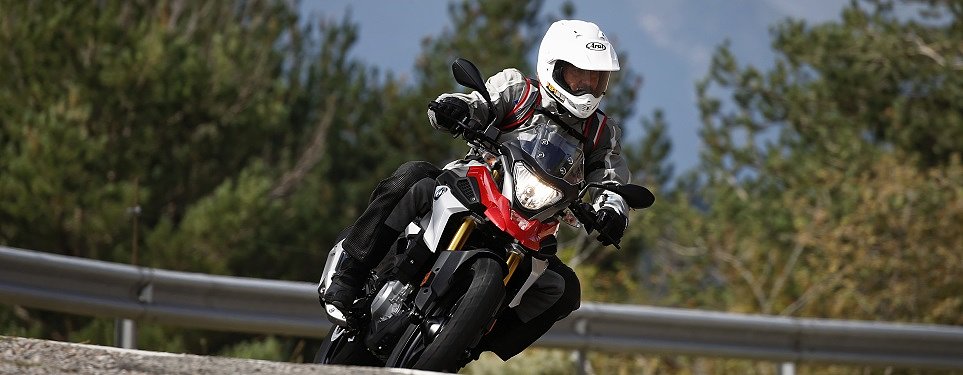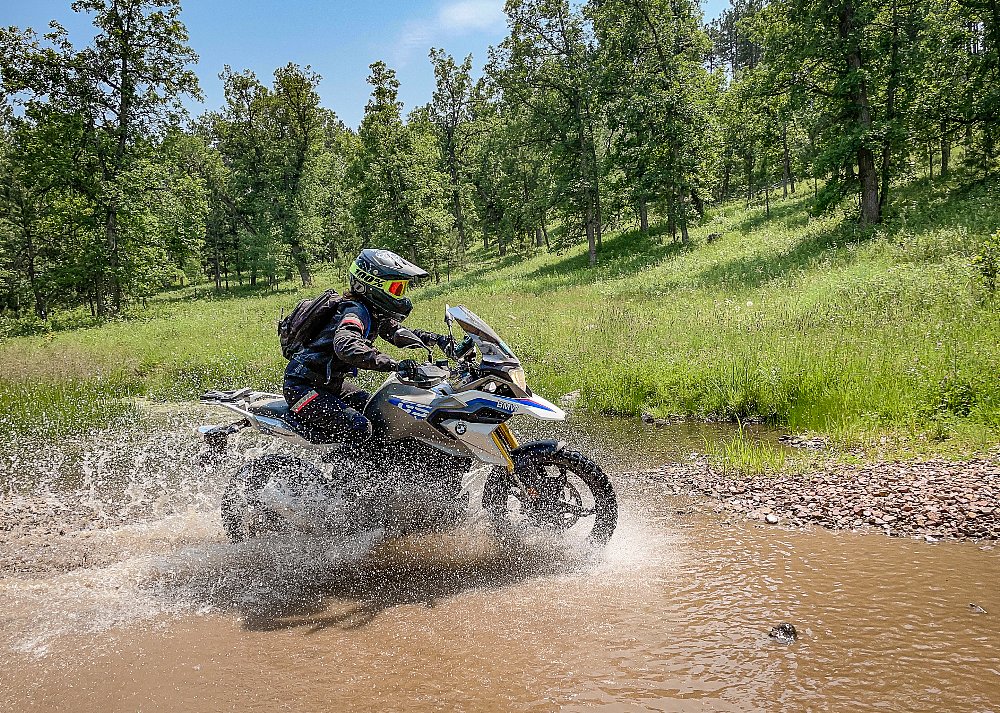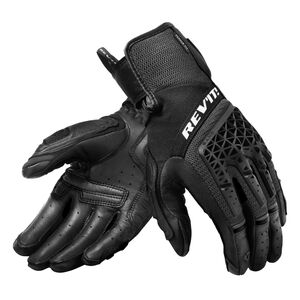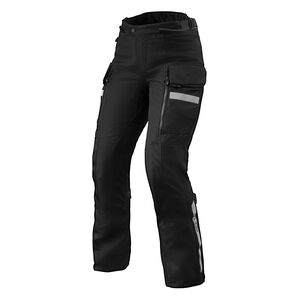Ding-ding-ding! In a boxing match of the featherweight dual-purpose beginner bikes, which contender would you put your money on? The Honda CRF300L Rally dual-sport machine, or the ADV-inspired BMW G 310 GS?
It is an unusual face-off, as the CRF is more often pitted against a similar style bike, such as the Kawasaki KLX 300. As for the G 310 GS, its usual adversaries would be the Royal Enfield Himalayan at 411 cc or the KTM 390 Adventure. But ever since I enjoyed riding a G 310 GS at the Get On! Adventure Festival last year, I’ve been curious — how would the strengths and weaknesses of an ADV bike versus a dual-sport bike stand up in a back-to-back comparison? Would there be some surprise jabs, or an unforeseen knock-out?
In the red corner and in the blue corner
In the red corner is the 2022 Honda CRF300L Rally. Weighing in at 331 pounds, with a claimed 27 horsepower punch and a 19.6 foot-pound jab, this Team Red contender rings in at a $6,099 MSRP. The CRF300L Rally has all the hallmarks of a dual-sport more oriented for the dirt. Kitted out with a 21-inch front wheel,18-inch rear wheel, and 10.2 inches of suspension travel, the CRF looks like a clear front-runner for off-road duty.
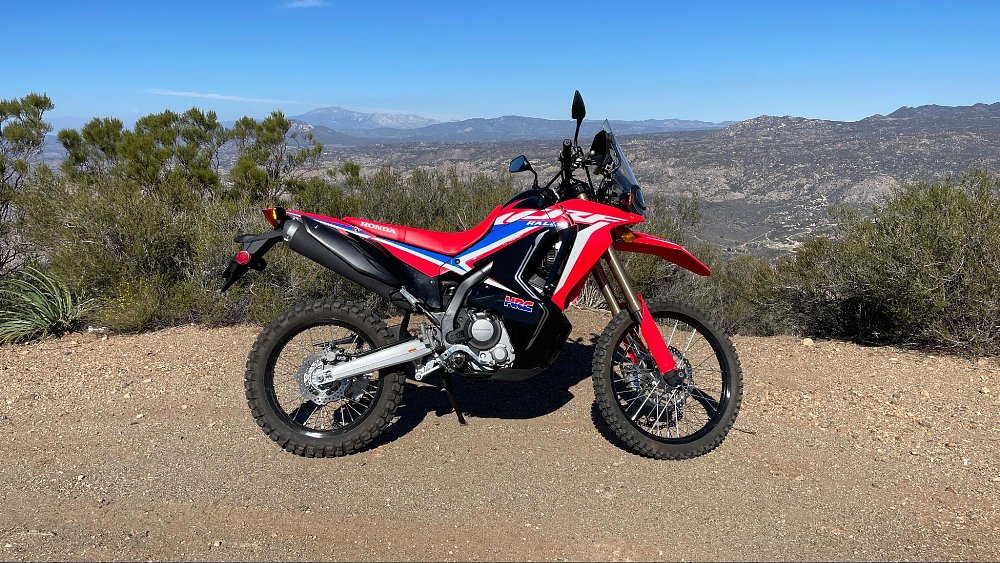
In the blue corner is a 2019 BMW G 310 GS. Weighing in at 386 pounds, with a claimed 34 horsepower punch and a 20 foot-pound jab, this German brawler rings in at a $5,695 MSRP.
This particular 310 GS comes with a history and is affectionately known as “Baby Shark.” A survivor of three Get On! Adventure Festivals and countless other local ADV rides, the Baby Shark and I have quite the rapport. Despite being a few years older, the 2019 G 310 GS is nearly identical to the 2023 offering. Some notable aftermarket changes to the Baby Shark, however, are the addition of Continental TKC 80 tires for better dirt performance, and a new handlebar after a small mishap at GOAF.

That all said, the BMW G 310 GS is undoubtedly better suited for the street. With a more powerful engine, a gearbox tailored for the road, and a shorter seat height, the 310 GS has appeal to new riders for both street and light duty dirt.
The chosen battle arena is a 50/50 split between asphalt and truck trail, with the added bonus of some more challenging single-track. I roped in some long-time riding buddies for a “musical chairs” approach to create a true back-to-back test ride on our featherweight contenders.
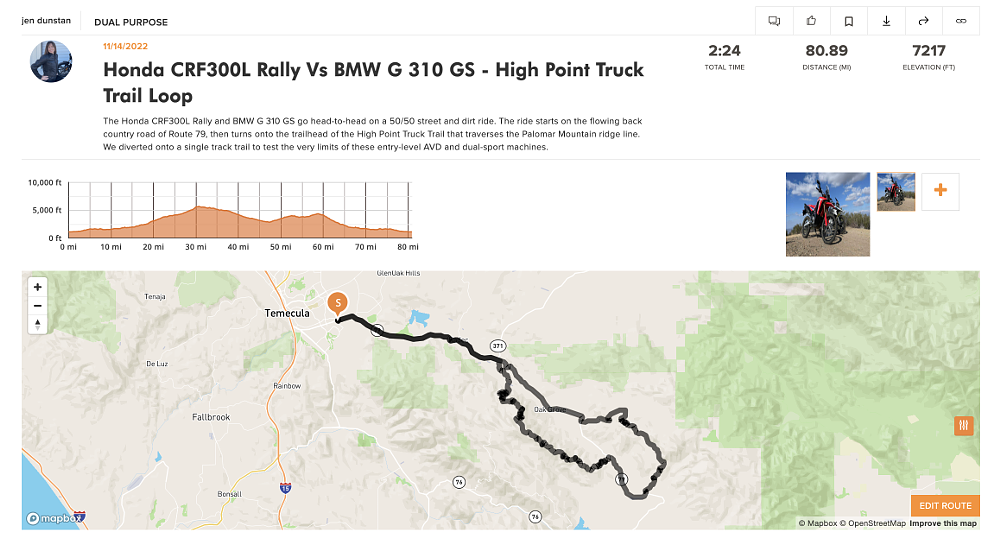
Round 1: The street ride
The inevitable pavement pounding before the trailhead is something every dual-purpose motorcycle will have to tackle. Our test bed consisted of fast and flowing back country roads with a sprinkling of tighter hairpins.
Straight away, the BMW pulls no punches in its street prowess. The BMW gearbox provides a much more pleasant ride on the street compared to the CRF. The CRF gearing for first through fourth gears is incredibly short, which means frantic up-shifting to get up to speed for the faster back country roads we were on. I can also imagine an annoying scenario for city riding where finding a happy medium somewhere between second or fourth gear for stop-and-go traffic would be a constant battle. Not so on the 310 GS, which has more consistent spacing between gears and also a forgiving powerband that lugs in a higher gear without complaint. The 310 GS also claims a top speed of 88 mph that I can vouch for, whereas the CRF struggles to reach 80 mph.
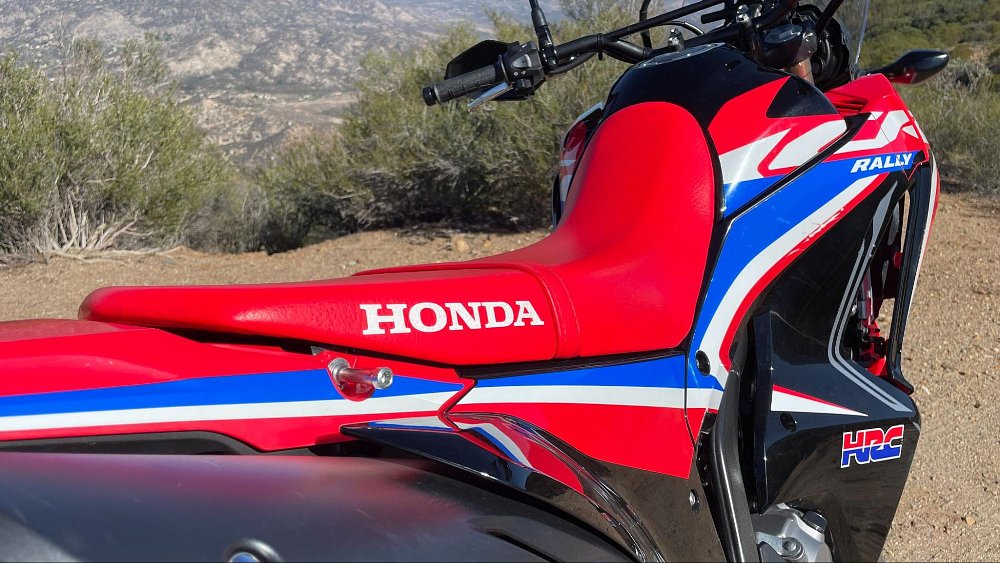
What the spec sheet doesn’t lay out in black and white is the performance of the two motorcycles in the corners. While neither bike is bringing particularly impressive suspension components to this brawl, the BMW felt better planted in the corners. The softer suspension of the CRF does no favors on any of the corners we met on the road, fast sweepers and tight twisties alike. The CRF also was hindered by its 21-inch front tire, which made turn-in feel vague, and the knobby tires contributed to a lack of confidence in cornering.
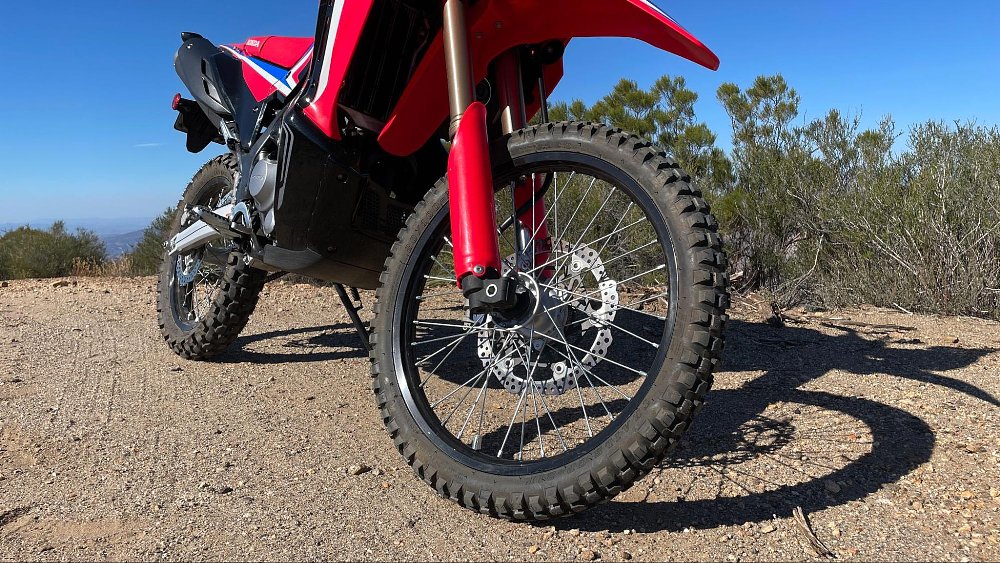
For creature comforts, the BMW G 310 GS has a more effective windscreen, plusher seat, and for the shorter rider a more manageable seat height (32.8 inches compared to the CRF’s 35.2 inches of seat height). I also noticed that the CRF has vibration at top speeds in all contact points — the grips, the seat, and the pegs. The BMW, in contrast, is a smooth operator, with no vibrations or numbing sensations. Finally, the BMW hosts a four-piston front brake caliper compared to the CRF’s two-piston front brake, and the result is a crisper stopping experience on the 310 GS while the CRF feels a tad mushy.
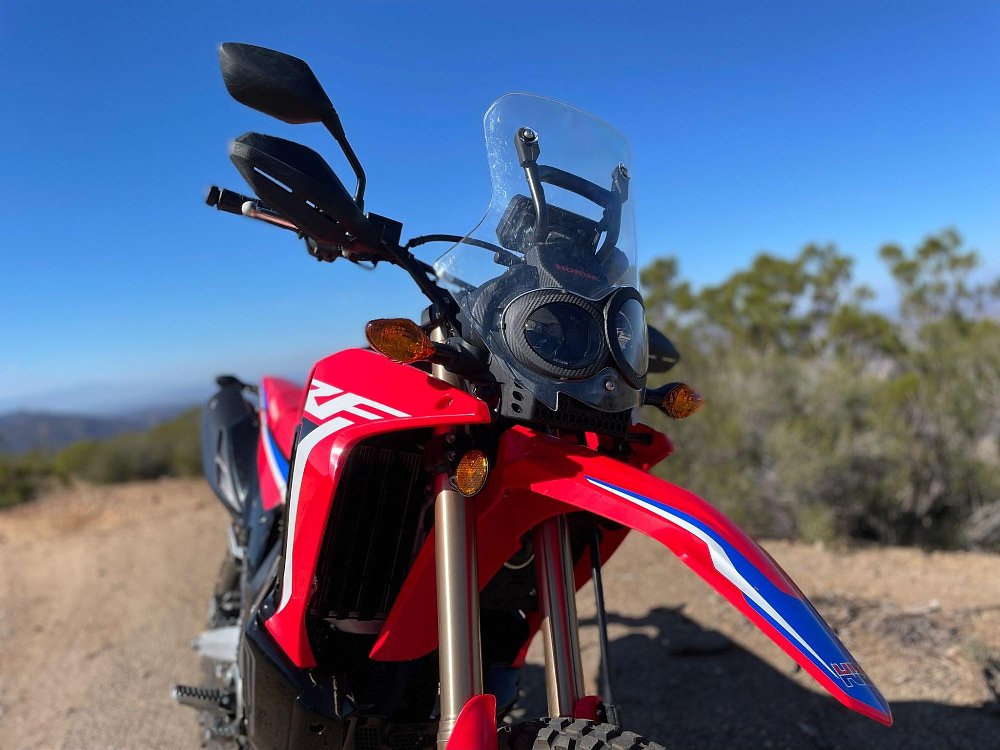
It was no surprise that round one went to the BMW G 310 GS. Marketed as an entry-level ADV bike, its strengths certainly paid off on the asphalt. As we approached the trailhead, however, expectations were high that the CRF300 Rally was going to exert its off-roading dominance.
Round 2: The single-track
Turning onto the truck trail, there was an optional single-track detour, usually meant for more capable dirt bikes and dual-sports. We wanted a real honest sparring match here between our modestly powered entry-level bikes, and what better place to find their limits than a technical rocky hill climb?
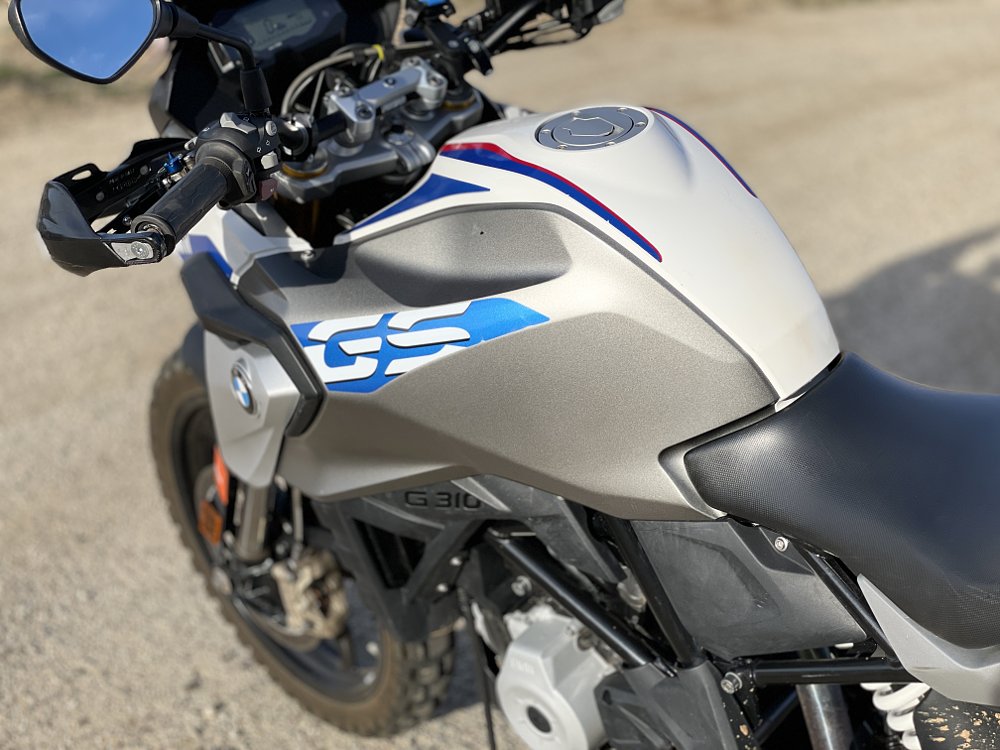
Standing up on the pegs, it is always a bit awkward to find a comfortable off-road position on the BMW. The shape of the gas tank is not tailored for a standing position and despite all my squeezing with the knees it was difficult to get a good grip with my legs. Also, the reach down to the handlebar is quite low, even for a shorter rider like myself, and the taller riders had an even more difficult time adjusting to the BMW ergonomics.
None the matter, I pinned the throttle and kept it in second gear for most of the climb. The BMW tractored with little fuss. I have been impressed before and reaffirm once again that the 310 GS is surprisingly effective at putting the power down to the ground. As the rocks grew larger and chunkier, the 310 GS suspension started to get out of shape. Its 7.1 inches of travel is a fair amount for an entry-level ADV bike, but here in this terrain the Baby Shark was meeting its limit. The inevitable thwacking began to sound from the fork, and I did all I could to find a more forgiving line up this rocky incline.
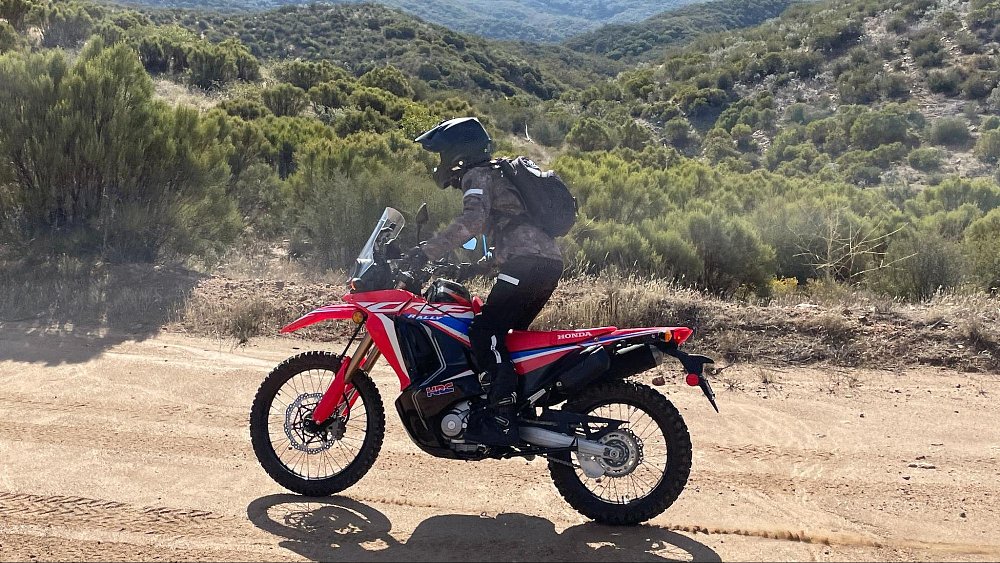
At the halfway point, I swapped seats and it was my turn to see how the CRF will perform in its natural environment. The first thing I noticed is that the CRF has better ergonomics for off-road riding. Right away in the standing position I felt more in control of the bike. My legs had good purchase on the gas tank and frame, and the upright handlebar created a comfortable rider triangle when I was out of the saddle.
That formerly cumbersome 21-inch wheel began to show its worth as it rolled through the rocks with relative ease. With a new commanding stance, bigger wheel and knobbier tire, I was feeling confident once again motoring up the rocky hill. I was a bit vexed, however, that the annoying short gearing played a role here in the dirt, too, and not for the better. Conventional thinking would imply that the shorter gearing would mean better usable power for the CRF in the slower speeds of the dirt, but I still had a hard time finding a gear the CRF would be happy operating in on this rocky climb. I found myself shifting back and forth between second and third, never quite finding a sweet spot that wasn’t wringing the CRF’s neck on the throttle.
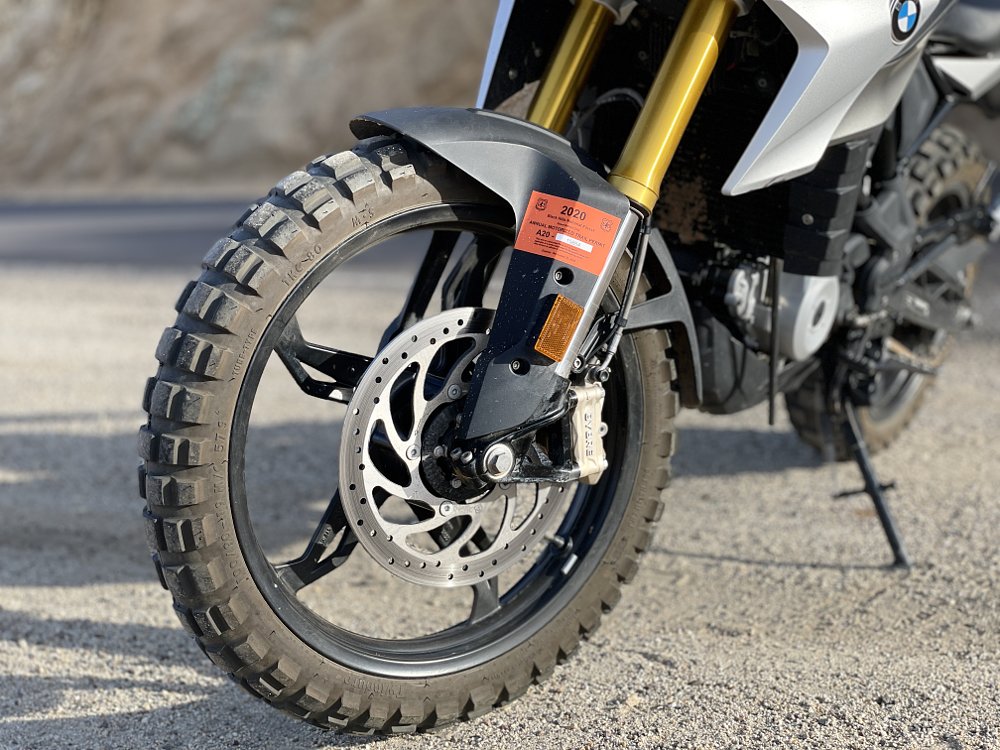
While the CRF had a notable 10.2 inches of suspension travel, what should be an obvious advantage over the BMW was actually difficult to take advantage of on the trail. The suspension was so soft the CRF was bottoming out quicker than the BMW, and also had the unappealing effect of bouncy rebound, so reclaiming control over the rocky terrain was an effort. Thanks to a better off-road position and a taller ground clearance (10.9 inches versus the BMW’s 8.6 inches), the CRF narrowly won round two of this boxing match.
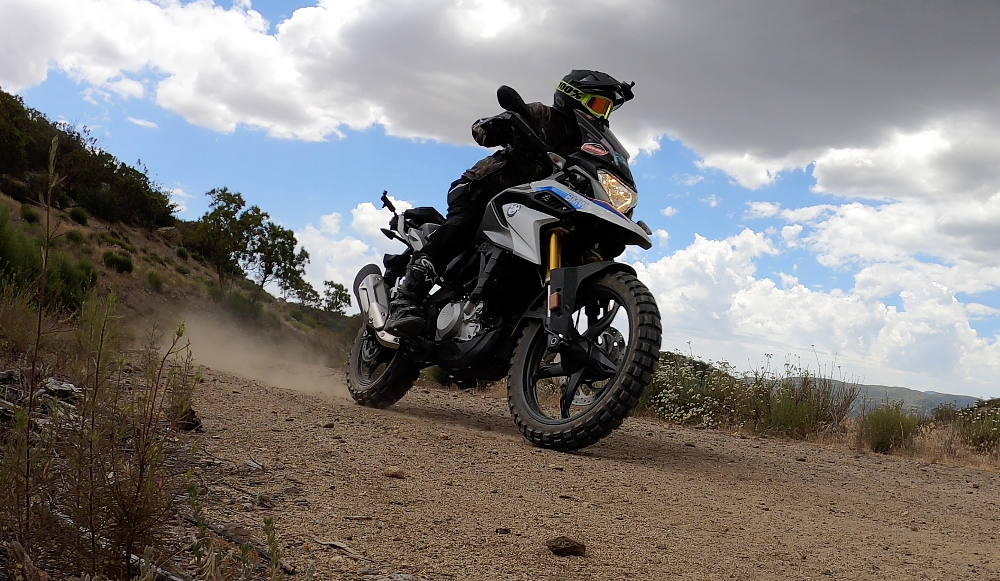
Round 3: The truck trail
We saved the best for last, and the undisputed dedicated application for both of these machines — a wide, easy truck trail. Once again, all test riders placed bets on how much better the CRF surely must be than the street-savvy BMW.
For the tame dirt trail we were on, the 310 GS coaxed me into its comfortable saddle and with its stiffer suspension a seated position on the truck trail was the ticket. In the corners, I preferred a foot-out flat-track method of cornering and the BMW tracked around the bends with ease. On the Honda, a standing position served me best and with my body helping to be an extension of the suspension travel the CRF300L Rally was also a pleasant companion on the dirt road.
While I enjoyed my time on both the CRF and 310 GS, a particular moment stuck out to me and was hard to ignore. A medium-sized dip on the truck trail caused a bottoming-out on the CRF, a scenario that sent a painful reverberation through my ankles. In all of the miles and terrain I have covered on Baby Shark in the past, never had I experienced such a harsh backlash from its suspension.
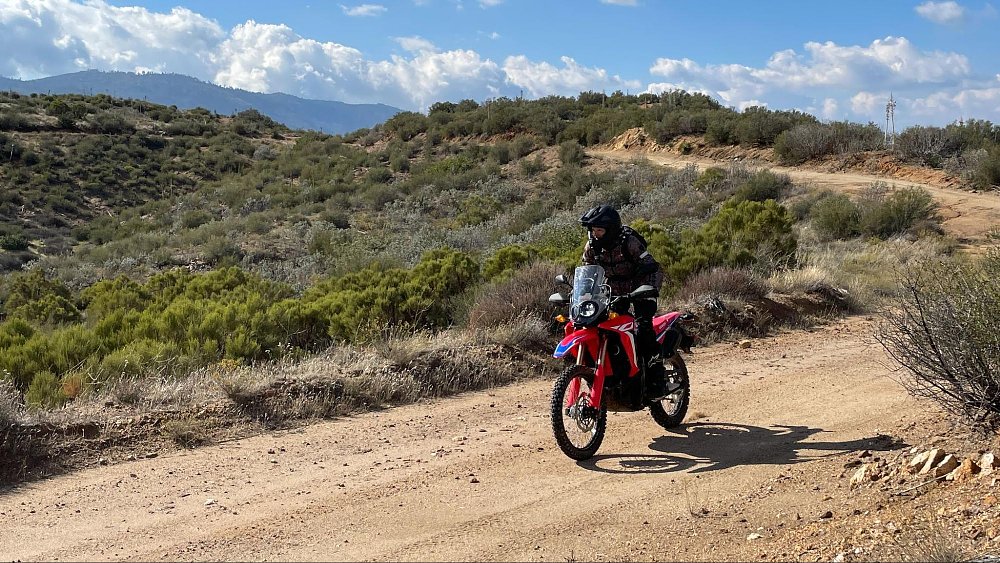
We had a consensus and it seems we aren’t the only ones who noticed the CRF300L Rally just has inexplicably soft suspension. With no adjustment options, it presents a serious conundrum for riders considering the CRF for any intermediate off-road duty, and apparently even so on this easy-rated truck trail. So which bike wins this round? Is there such a thing as a draw in boxing?
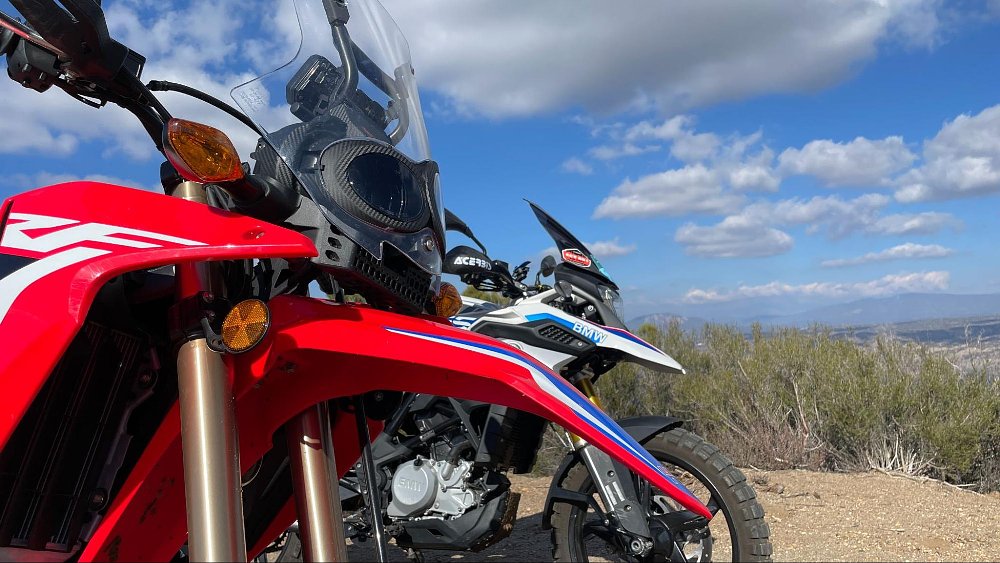
Final round of thoughts
I have to admit to an underlying bias towards my tried and true BMW G 310 GS. It has a nickname, after all, and it has traveled with me to distant lands to ride terrain that it really shouldn’t (but still does) and at a level that continues to impress me. Perhaps because expectations are so low, every time the Baby Shark delivers it feels like an underdog victory.
On the flip side, the Honda CRF300L Rally is meant to be the clear favorite in this boxing match. With a rap sheet tuned for dirt duty and a loyal fan base, I honestly thought the CRF would blow Baby Shark out of the water. But the thing is, it didn’t. Where the CRF should have been head and shoulders better than the BMW, it was only marginally, and debatably, so.
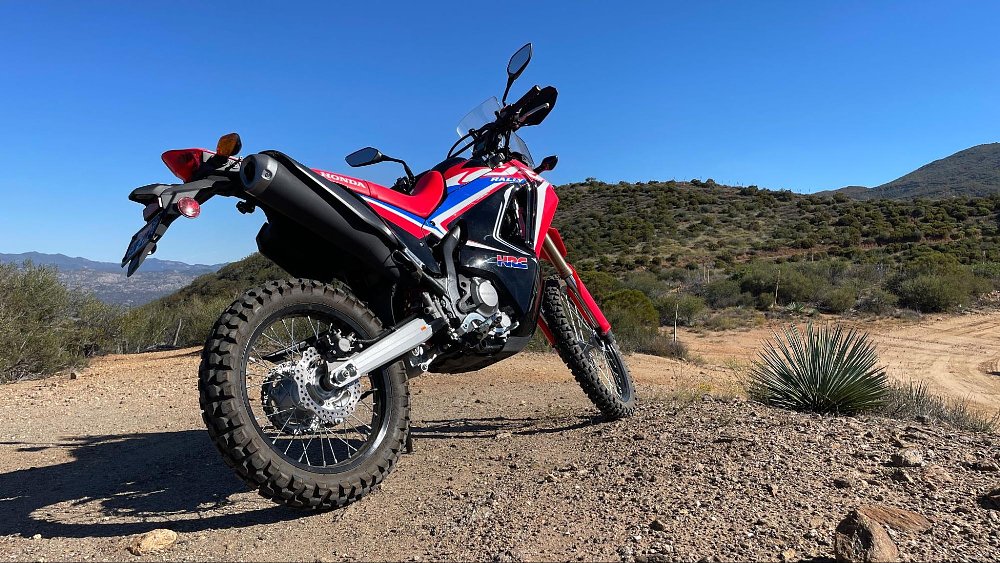
As I ring the final bell on this head-to-head review, it is important to acknowledge that every rider shopping these bikes right now has their own unique needs and demands for their two wheels. With that in mind, I can make the following recommendations:
For the rider who anticipates doing 70% street riding and 30% dirt riding, I do recommend the BMW G 310 GS in this instance. It is undeniably the better street bike of the two.
For the rider who anticipates doing 70% off-road riding, and 30% street riding, after much hesitation I do recommend the Honda CRF300L Rally. I acknowledge that the CRF is more comfortable for the standing position that off-roading calls for, it will fit the majority of taller riders better, and its tire sizes and other parameters lend itself to more customization options to enhance its dirt capabilities.
No sensational knock-outs in this boxing ring of the beginner dual-purpose motorcycles. It was instead a good 12-round bout for the title. Despite the critical side-by-side comparison, it’s encouraging to see that these budget-friendly options have a lot to offer for the dirt-curious rider. Which one is going to be your best sparring partner? Choose your fighter, choose your arena, and ring that bell.
| 2022 Honda CRF300L Rally | 2019 BMW G 310 GS | |
|---|---|---|
| Price (MSRP) | $6,099 | $5,695 |
| Engine |
286 cc liquid-cooled, four-valve, single-cylinder four-stroke |
313 cc liquid-cooled, four-valve, single-cylinder four-stroke |
|
Transmission, final drive |
Six-speed, chain | Six-speed, chain |
| Claimed horsepower | 27 @ 8,500 rpm | 34 @ 9,250 rpm |
| Claimed torque | 19.6 foot-pounds @ 6,500 | 20 foot-pounds @ 7,500 rpm |
| Frame |
|
Tubular space frame |
| Front suspension |
43 mm inverted fork; 10.2 inches of travel |
41 mm Inverted fork, 7.1 inches of travel |
| Rear suspension |
Pro-Link® single shock with spring; 10.2 inches of travel |
Central spring strut, pre-load adjustable; 7.1 inches of travel |
| Front brake |
Single 296 mm disc with two-piston caliper, ABS optional |
Single 11.8-inch disc, four-piston fixed caliper, radially mounted, ABS |
| Rear brake |
Single 220 mm disc, ABS optional |
Single 9.5-inch disc, single-piston floating caliper, ABS |
| Wheelbase | 57.2 inches | 55.9 inches |
| Seat height | 35.2 inches | 32.8 inches |
| Fuel capacity | 3.4 gallons | 3.0 gallons |
| Tires |
80/100-21 , 120/80-18 |
110/80 R19, 150/70 R17 |
| Claimed weight | 331 pounds (wet) | 386 pounds (wet) |
| Available | Now | Now |
| Warranty | 12 months, unlimited miles | 12 months |
| More info | powersports.honda.com | bmwmotorcycles.com |






